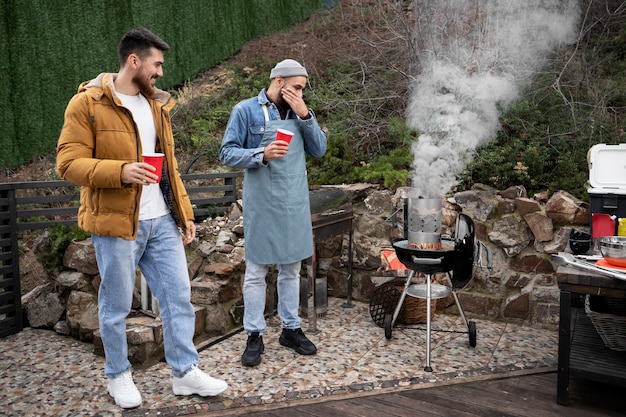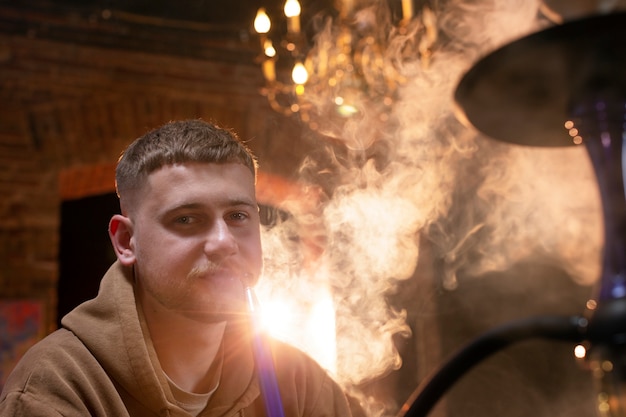So, you're thinking about diving into the world of smoker cooking, are you? Let me tell you, it’s an absolute game-changer. I used to think grilling was the peak of outdoor cooking, but then I discovered the magic of smoking. It’s a whole other level of flavor, a whole other kind of culinary experience. The smoky aroma wafting through the air is intoxicating, and then there's the taste – juicy, tender, unbelievably flavorful dishes that are simply divine. It feels like magic, honestly, but don’t worry, it’s not as intimidating as it seems. I’m going to take you on a journey, step by step, and show you exactly how to get started with smoker cooking. Trust me, by the end of this guide, you’ll be whipping up mouthwatering smoked meals like a seasoned pro.
(Part 1) Picking Your Weapon: Choosing the Right Smoker

First things first, you need to choose your smoker. There's a whole world of smokers out there, from the simple and straightforward to the fancy and high-tech. Don’t get overwhelmed though, we're going to break it all down. It's all about finding the right fit for your needs and your budget.
1.1. The Classic: offset smokers
Imagine a big, barrel-shaped cooking chamber with a firebox tucked off to the side. That's your classic offset smoker, the workhorse of the smoking world. These trusty machines have been around for ages, and they're known for their ability to distribute heat evenly and produce a deep, beautiful smoky flavor. If you're just starting out, an offset smoker is an excellent choice. Plus, they’re typically very affordable. I remember my first offset smoker, a real beauty with a gleaming finish. I was so proud of it!
1.2. The Upgrader: Pellet Smokers
Now, if you’re looking for a little more convenience and consistency, pellet smokers are where it’s at. They use wood pellets to generate both heat and smoke, making them incredibly easy to use and maintain. Simply set the temperature and let the smoker do its thing. They’re a bit pricier than offset smokers, but they're definitely worth considering if you want a hands-off approach. Pellet smokers are perfect if you have a busy schedule or just want to spend less time fussing with the fire. Set it and forget it – that’s the beauty of pellet smokers!
1.3. The Compact Choice: electric smokers
And then there's the electric smoker. It’s a fantastic option if you have limited space or are just starting your smoker cooking journey. They’re super easy to use, relatively inexpensive, and don't take up much space. While they’re not as powerful as the other options, they can still produce impressive results, especially for smaller cuts of meat. My neighbor swears by his electric smoker; he uses it for everything from chicken to fish!
(Part 2) Fueling the Fire: Choosing the Right Wood

Now, let’s talk about wood. Choosing the right wood is essential for creating the perfect smoky flavor, and it's all about finding the perfect flavor profile to complement your chosen meat.
2.1. The Classics
For a classic, robust smoky flavor, you can't go wrong with hickory, oak, or pecan. These woods are known for their strong, rich smoke that pairs beautifully with almost any type of meat. If you're cooking ribs, brisket, or pork shoulder, these are your go-to choices.
2.2. The Fruity Options
If you want to add a touch of sweetness and complexity to your smoke, try fruit woods like apple, cherry, or maple. They're fantastic for poultry, fish, or even vegetables. I’ve always loved the way a hint of cherry wood enhances the natural sweetness of salmon. It’s a truly divine combination!
2.3. The Bold Flavours
For a bolder, more intense smoky flavor, consider mesquite or alder. These are strong woods that will impart a distinctive taste to your food. They're perfect for heartier meats like beef or lamb.
(Part 3) Setting the Stage: Preparing Your Smoker

Alright, you’ve got your smoker and you’ve chosen your wood, now it’s time to get everything set up. It’s important to start with a clean smoker and to prepare your wood for the best smoking experience.
3.1. Cleaning Your Smoker
Before you even think about firing up your smoker, give it a thorough cleaning. Wipe down the cooking chamber, the grates, and the firebox to remove any leftover ash, food particles, or grease. Trust me, it's worth the effort. It'll make your life much easier and ensure your food tastes its absolute best.
3.2. Soaking Your Wood
Now, let’s talk about soaking your wood. This is a critical step, especially if you're using wood chunks or chips. Soaking them in water for at least 30 minutes will help them smolder longer and produce more smoke. I've learned this the hard way. Once, I forgot to soak my wood chips, and they burned up in a flash, leaving me with hardly any smoke. It was a culinary disaster!
(Part 4) Getting the Temperature Right: Controlling Your Smoker
This is one of the most important aspects of smoker cooking, and it can be a bit tricky at first. But with a little practice, you'll be a pro in no time.
4.1. Using a Thermometer
First off, you need a good thermometer. This is your essential tool, your lifeline. It'll tell you the temperature inside your smoker, which is crucial for controlling how your food cooks. I swear by my digital thermometer; it's accurate and easy to use. Don't even think about trying to smoke without one!
4.2. Understanding the Temperatures
Different meats require different smoking temperatures. For example, brisket usually smokes at around 225°F (107°C), while chicken is often smoked at a slightly higher temperature. It’s all about finding the right temperature for the specific type of meat you’re cooking.
4.3. Adjusting the Fire
Finally, you need to master the art of adjusting the fire. You'll need to add more wood or fuel to keep the temperature consistent. This might take a bit of practice, but you'll get the hang of it. There's nothing quite like watching a fire burn and knowing that you’re in control of the smoking process.
(Part 5) Meat Prep: The Secret to Tender and Flavorful Dishes
Alright, let’s talk about the star of the show – the meat! The way you prepare your meat will have a massive impact on the final result.
5.1. Brining and Seasoning
Brining is a total game-changer. It involves soaking your meat in a salt-water solution, which helps to keep it moist and incredibly tender. You can also add spices and herbs to your brine for an extra layer of flavor. I love to brine my pork shoulder with a blend of garlic, peppercorns, and bay leaves. It always turns out unbelievably juicy and flavorful.
5.2. Rubbing It In
Now, let’s talk about dry rubs. These are mixtures of spices that you rub all over your meat before smoking it. They add flavor and create a beautiful, crispy crust on the outside. You can buy pre-made rubs, or you can create your own. I have a secret recipe for a dry rub that includes smoked paprika, cumin, and brown sugar. I’m not sharing it though!
5.3. The Importance of Patience
Remember, smoker cooking is all about patience. Don't rush it; give the meat time to cook slowly and develop those incredible smoky flavors. Just relax and let it do its thing. And hey, while you’re waiting, you can always unwind and enjoy a cold drink.
(Part 6) The Smoking Process: From Start to Finish
Alright, let’s discuss the actual smoking process. We're going to break it down into easy-to-follow steps so you can create your own smoky masterpieces.
6.1. Building the Fire
Start by building a fire in your smoker's firebox. Use the type of wood you've chosen and make sure it's burning hot. If you're using a pellet smoker, simply fill the hopper with pellets and set the desired temperature.
6.2. Setting the Meat
Once your smoker is up to temperature, carefully place the meat on the grates. Leave some space between the pieces of meat so that the smoke can circulate evenly. Remember, we want that smoky goodness to reach every corner!
6.3. Maintaining the Temperature
Now, you need to keep a close eye on the temperature and adjust the fire as needed. This is where your trusty thermometer comes into play. You're going to be checking it every so often to ensure that the temperature remains consistent. Think of it like babysitting, but with smoke!
6.4. The Importance of Smoke
Here's a little tip: Don't be afraid of smoke. That smoky aroma is what gives your food its unique character. You're aiming for a gentle, steady stream of smoke, not a raging inferno. Let the magic happen!
(Part 7) The Finishing Touches: Wrapping, Resting, and Serving
Almost there! You’ve smoked your meat, now it’s time to finish things off. The last few steps are crucial for achieving a perfect, tender, and flavorful smoked dish.
7.1. Wrapping the Meat
For some meats, like brisket, it's recommended to wrap them in foil for the last part of the smoking process. This helps to retain moisture and make the meat even more tender. Just make sure to leave the foil open on one side so that the smoke can still get in.
7.2. Letting it Rest
Once your meat is cooked through, let it rest for at least 30 minutes before slicing it. This allows the juices to redistribute throughout the meat, making your dish incredibly tender and flavorful. I know it’s hard to wait, but trust me, it’s worth it!
7.3. Serving with Pride
And finally, you’re ready to serve your delicious smoked dish. Slice it up, add some of your favorite sides, and enjoy! You’ve earned it, you smoking rockstar!
(Part 8) Beyond the Basics: Tips for Success
Now that you’ve got the basics down, here are a few extra tips to help you become a smoker cooking master.
8.1. The Importance of Water
Use a water pan! It helps to control the humidity in your smoker and prevent your food from drying out. You can add things like apple cider vinegar or fruit juices to your water pan for extra flavor. It's like a little secret sauce, but for your smoker!
8.2. Using a Spritzer
Keep a spray bottle handy. You can use it to spritz your meat with water, apple juice, or other liquids to keep it moist during the smoking process. This is especially helpful for meats that are prone to drying out, like chicken or fish.
8.3. The Art of Smoking Vegetables
Don’t limit yourself to just meat! You can smoke vegetables too. Think corn on the cob, asparagus, or even Brussels sprouts. I’ve even smoked my own tomatoes, and let me tell you, they’re out of this world!
8.4. The Value of Patience
And last but not least, remember to be patient. Smoker cooking takes time. It's not a quick fix, it's a journey. So relax, enjoy the process, and let the smoke work its magic.
FAQs
Got some questions? Here are a few common ones that I get asked all the time.
1. How do I know when my meat is cooked through?
You need to use a meat thermometer to check the internal temperature of your meat. Different meats have different recommended temperatures. For example, pork should be cooked to 145°F (63°C), while beef should be cooked to 145°F (63°C) for medium-rare. You can find a detailed chart of recommended temperatures online or in a cookbook.
2. What’s the best way to clean my smoker?
The easiest way to clean your smoker is to do it after each use. Remove the grates and any other removable parts and scrub them with soapy water. Then, use a damp cloth to wipe down the inside of the smoker. You can also use a scraper to remove any leftover ash or food particles. Remember to let everything dry completely before putting it back together.
3. How do I choose the right wood for my meat?
Think about the flavor profile you’re aiming for. For example, hickory, oak, and pecan have a strong, smoky flavor that’s perfect for beef, pork, and chicken. Fruit woods like apple, cherry, and maple add sweetness and complexity to the smoke, which pairs well with poultry, fish, and even vegetables. Mesquite and alder are bold, smoky woods that are perfect for heartier meats like beef and lamb.
4. What are some good beginner smoker recipes?
There are tons of great beginner recipes out there. Try smoking chicken, pork shoulder, or ribs. These are relatively easy to smoke and don’t require a lot of experience. You can find plenty of recipes online or in cookbooks.
5. What are some of the most common mistakes beginner smokers make?
One common mistake is not paying attention to the temperature. It’s crucial to maintain a consistent temperature throughout the smoking process. Another mistake is not using a water pan, which can lead to dry meat. Also, remember to soak your wood chips or chunks before using them. It will help them to smolder longer and produce more smoke.
Now, you’re ready to take the plunge. Go ahead, get that smoker fired up, and start creating some delicious, smoky goodness. You’re going to love it!
Everyone is watching

Prime Rib Roast Cooking Time Chart: Per Pound Guide
Cooking TipsPrime rib roast. Just the name conjures images of lavish dinners, crackling fires, and hearty laughter. It’s ...

How Long to Bake Potatoes in the Oven (Perfect Every Time)
Cooking TipsBaked potatoes are a staple in my kitchen. They're incredibly versatile, delicious, and surprisingly easy to m...

Perfect Rice Every Time: The Ultimate Guide to Cooking Rice
Cooking TipsAs a self-proclaimed foodie, I've always been a bit obsessed with rice. It's the foundation of countless cuisi...

The Ultimate Guide to Cooking Asparagus: Tips, Techniques, and Recipes
Cooking TipsAsparagus. The mere mention of this spring delicacy conjures up images of vibrant green spears, crisp and burs...

Ultimate Guide to Cooking the Perfect Thanksgiving Turkey
Cooking TipsThanksgiving. Just the word conjures up images of overflowing tables laden with delicious food, the scent of r...
